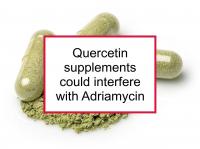A new study presented in April at the annual AACR (American Association for Cancer Research) meeting reported that while quercetin appears to protect heart cells from the toxic effects of doxorubicin, it can also reduce doxorubicin's cytotoxic treatment effects in some types of breast cancer cells.
Best food sources of quercetin
There is some evidence that the impact of flavonoids on breast cancer cells depends on the dosage, with low or high doses potentially stimulating breast cancer cell growth in some cases. When flavonoids are consumed as part of food, they are combined with other micronutrients that have been shown to act synergistically against breast cancer. Consuming flavonoid-rich foods is safe. On the other hand, safe and effective dosages of flavonoid supplements have not been established and such supplementation has the potential to increase breast cancer risk and reduce the effectiveness of treatment. Based on the available evidence, we conclude that quercetin should not be taken in supplement form.
Quercetin is abundant in the following foods:
Latest research finds quercetin can have dual role
The study referenced at the beginning of this news article was designed to investigate the actions of quercetin in breast cancer cells treated with doxorubicin. The authors first demonstrated that quercetin significantly protected an aorta model from doxorubicin-induced vascular toxicity. The ability of quercetin to protect the integrity of blood vessels may, in part, explain how it protects the heart. The authors then tested quercetin-doxorubicin combinations in ER+/PR+ (MCF-7 and T47D) and triple negative (MDA-MB-231) breast cancer cells.
Two drugs are considered synergistic if the combination is more effective than each drug used separately. On the other hand, two drugs are considered antagonistic if the combination is less effective, i.e., one of the drugs counteracts the actions of the other. One way to evaluate whether a combination is synergistic or antagonistic to calculate a combination index (CI) based on drug cytotoxicity curves.
Quercetin was found to double the IC50 (half maximal inhibitory concentration) of doxorubicin (from 0.4±0.03 to 0.8±0.06 μM) in MCF-7 cells and the CI value also indicated strong antagonism (i.e., reduction of its treatment efficacy). The IC50 of doxorubicin was not altered by quercetin in triple negative breast cancer cells, however the CI was indicative of antagonism. On the other hand, the quercetin-doxorubicin combination was synergistic in T47D cells, with an improved IC50 (reduced from 0.74±0.05 to 0.36±0.003 μM) and more favorable CI value.
Most solid tumors contain hypoxic regions with low oxygen conditions due to inadequate blood supply. Under hypoxic conditions, quercetin was found to synergize doxorubicin's cytotoxicity against MCF7 cells, significantly reducing its IC50. Additional experiments demonstrated that the combination of quercetin with doxorubicin significantly increased the concentration of pro-caspase 3 (which is involved in programmed cell death) compared to doxorubicin alone in T47D and triple negative cells. The authors conclude that, while quercetin protects vascular tissue from doxorubicin, it also has antagonistic to borderline synergistic interactions with doxorubicin in three different breast cancer cell lines.
Please see our article on what to eat while on doxorubicin for more information.
